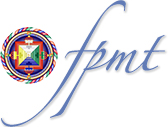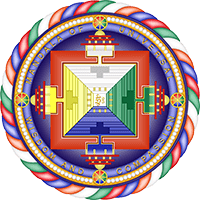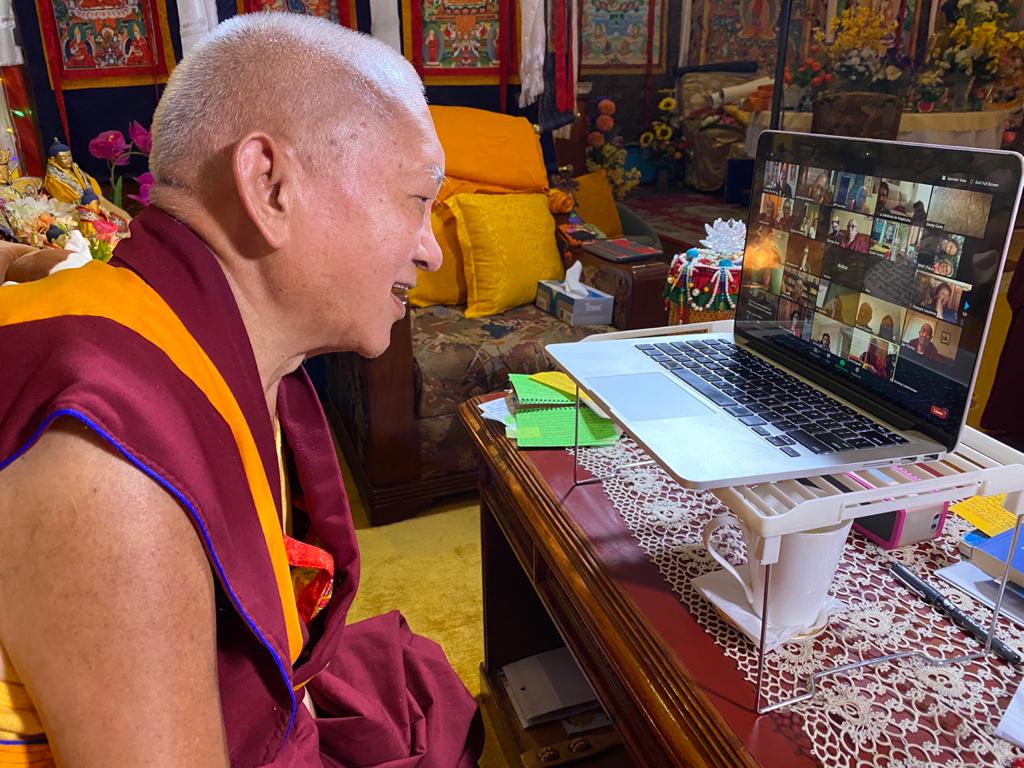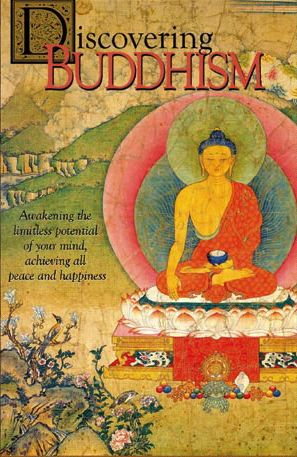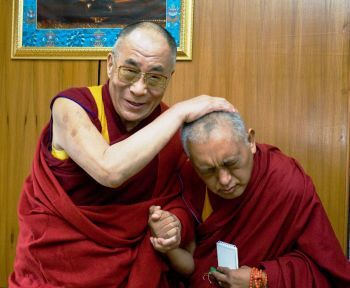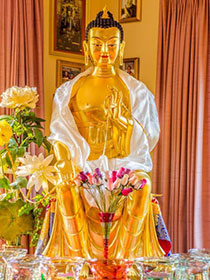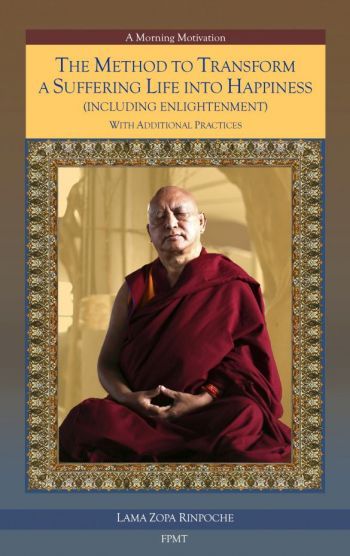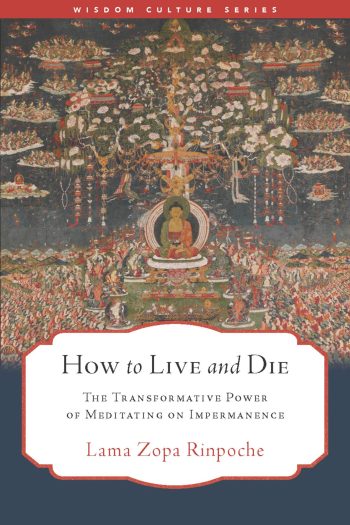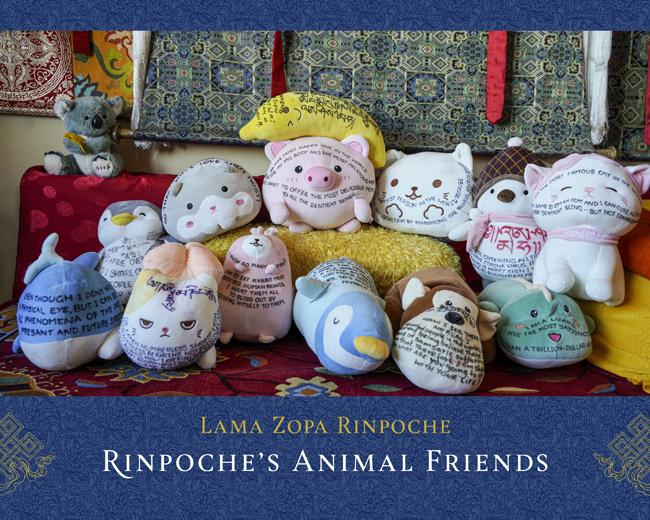- Home
- FPMT Homepage
Foundation for the Preservation of the Mahayana Tradition
The FPMT is an organization devoted to preserving and spreading Mahayana Buddhism worldwide by creating opportunities to listen, reflect, meditate, practice and actualize the unmistaken teachings of the Buddha and based on that experience spreading the Dharma to sentient beings. We provide integrated education through which people’s minds and hearts can be transformed into their highest potential for the benefit of others, inspired by an attitude of universal responsibility and service. We are committed to creating harmonious environments and helping all beings develop their full potential of infinite wisdom and compassion. Our organization is based on the Buddhist tradition of Lama Tsongkhapa of Tibet as taught to us by our founders Lama Thubten Yeshe and Lama Thubten Zopa Rinpoche.
- Willkommen
Die Stiftung zur Erhaltung der Mahayana Tradition (FPMT) ist eine Organisation, die sich weltweit für die Erhaltung und Verbreitung des Mahayana-Buddhismus einsetzt, indem sie Möglichkeiten schafft, den makellosen Lehren des Buddha zuzuhören, über sie zur reflektieren und zu meditieren und auf der Grundlage dieser Erfahrung das Dharma unter den Lebewesen zu verbreiten.
Wir bieten integrierte Schulungswege an, durch denen der Geist und das Herz der Menschen in ihr höchstes Potential verwandelt werden zum Wohl der anderen – inspiriert durch eine Haltung der universellen Verantwortung und dem Wunsch zu dienen. Wir haben uns verpflichtet, harmonische Umgebungen zu schaffen und allen Wesen zu helfen, ihr volles Potenzial unendlicher Weisheit und grenzenlosen Mitgefühls zu verwirklichen.
Unsere Organisation basiert auf der buddhistischen Tradition von Lama Tsongkhapa von Tibet, so wie sie uns von unseren Gründern Lama Thubten Yeshe und Lama Thubten Zopa Rinpoche gelehrt wird.
- Bienvenidos
La Fundación para la preservación de la tradición Mahayana (FPMT) es una organización que se dedica a preservar y difundir el budismo Mahayana en todo el mundo, creando oportunidades para escuchar, reflexionar, meditar, practicar y actualizar las enseñanzas inconfundibles de Buda y en base a esa experiencia difundir el Dharma a los seres.
Proporcionamos una educación integrada a través de la cual las mentes y los corazones de las personas se pueden transformar en su mayor potencial para el beneficio de los demás, inspirados por una actitud de responsabilidad y servicio universales. Estamos comprometidos a crear ambientes armoniosos y ayudar a todos los seres a desarrollar todo su potencial de infinita sabiduría y compasión.
Nuestra organización se basa en la tradición budista de Lama Tsongkhapa del Tíbet como nos lo enseñaron nuestros fundadores Lama Thubten Yeshe y Lama Zopa Rinpoche.
A continuación puede ver una lista de los centros y sus páginas web en su lengua preferida.
- Bienvenue
L’organisation de la FPMT a pour vocation la préservation et la diffusion du bouddhisme du mahayana dans le monde entier. Elle offre l’opportunité d’écouter, de réfléchir, de méditer, de pratiquer et de réaliser les enseignements excellents du Bouddha, pour ensuite transmettre le Dharma à tous les êtres. Nous proposons une formation intégrée grâce à laquelle le cœur et l’esprit de chacun peuvent accomplir leur potentiel le plus élevé pour le bien d’autrui, inspirés par le sens du service et une responsabilité universelle. Nous nous engageons à créer un environnement harmonieux et à aider tous les êtres à épanouir leur potentiel illimité de compassion et de sagesse. Notre organisation s’appuie sur la tradition guéloukpa de Lama Tsongkhapa du Tibet, telle qu’elle a été enseignée par nos fondateurs Lama Thoubtèn Yéshé et Lama Zopa Rinpoché.
Visitez le site de notre Editions Mahayana pour les traductions, conseils et nouvelles du Bureau international en français.
Voici une liste de centres et de leurs sites dans votre langue préférée
- Benvenuto
L’FPMT è un organizzazione il cui scopo è preservare e diffondere il Buddhismo Mahayana nel mondo, creando occasioni di ascolto, riflessione, meditazione e pratica dei perfetti insegnamenti del Buddha, al fine di attualizzare e diffondere il Dharma fra tutti gli esseri senzienti.
Offriamo un’educazione integrata, che può trasformare la mente e i cuori delle persone nel loro massimo potenziale, per il beneficio di tutti gli esseri, ispirati da un’attitudine di responsabilità universale e di servizio.
Il nostro obiettivo è quello di creare contesti armoniosi e aiutare tutti gli esseri a sviluppare in modo completo le proprie potenzialità di infinita saggezza e compassione.
La nostra organizzazione si basa sulla tradizione buddhista di Lama Tsongkhapa del Tibet, così come ci è stata insegnata dai nostri fondatori Lama Thubten Yeshe e Lama Zopa Rinpoche.
Di seguito potete trovare un elenco dei centri e dei loro siti nella lingua da voi prescelta.
- 欢迎 / 歡迎
简体中文
“护持大乘法脉基金会”( 英文简称:FPMT。全名:Foundation for the Preservation of the Mahayana Tradition) 是一个致力于护持和弘扬大乘佛法的国际佛教组织。我们提供听闻,思维,禅修,修行和实证佛陀无误教法的机会,以便让一切众生都能够享受佛法的指引和滋润。
我们全力创造和谐融洽的环境, 为人们提供解行并重的完整佛法教育,以便启发内在的环宇悲心及责任心,并开发内心所蕴藏的巨大潜能 — 无限的智慧与悲心 — 以便利益和服务一切有情。
FPMT的创办人是图腾耶喜喇嘛和喇嘛梭巴仁波切。我们所修习的是由两位上师所教导的,西藏喀巴大师的佛法传承。
繁體中文
護持大乘法脈基金會”( 英文簡稱:FPMT。全名:Found
ation for the Preservation of the Mahayana Tradition ) 是一個致力於護持和弘揚大乘佛法的國際佛教組織。我們提供聽聞, 思維,禪修,修行和實證佛陀無誤教法的機會,以便讓一切眾生都能 夠享受佛法的指引和滋潤。 我們全力創造和諧融洽的環境,
為人們提供解行並重的完整佛法教育,以便啟發內在的環宇悲心及責 任心,並開發內心所蘊藏的巨大潛能 — 無限的智慧與悲心 – – 以便利益和服務一切有情。 FPMT的創辦人是圖騰耶喜喇嘛和喇嘛梭巴仁波切。
我們所修習的是由兩位上師所教導的,西藏喀巴大師的佛法傳承。 察看道场信息:
- FPMT Homepage
- News/Media
-
- Study & Practice
-
-
- About FPMT Education Services
- Latest News
- Programs
- New to Buddhism?
- Buddhist Mind Science: Activating Your Potential
- Heart Advice for Death and Dying
- Discovering Buddhism
- Living in the Path
- Exploring Buddhism
- FPMT Basic Program
- FPMT Masters Program
- FPMT In-Depth Meditation Training
- Maitripa College
- Lotsawa Rinchen Zangpo Translator Program
- Universal Education for Compassion & Wisdom
- Online Learning Center
-
- Prayers & Practice Materials
- Overview of Prayers & Practices
- Full Catalogue of Prayers & Practice Materials
- Explore Popular Topics
- Benefiting Animals
- Chenrezig Resources
- Death & Dying Resources
- Lama Chopa (Guru Puja)
- Lama Zopa Rinpoche: Compendium of Precious Instructions
- Lama Zopa Rinpoche: Life Practice Advice
- Lama Zopa Rinpoche Practice Series
- Lamrim Resources
- Mantras
- Prayer Book Updates
- Purification Practices
- Sutras
- Thought Transformation (Lojong)
- Audio Materials
- Dharma Dates - Tibetan Calendar
- Translation Services
- Publishing Services
- Ways to Offer Support
- Prayers & Practice Materials
-
- Teachings and Advice
- Find Teachings and Advice
- Lama Zopa Rinpoche Advice Page
- Lama Zopa Rinpoche: Compendium of Precious Instructions
- Lama Zopa Rinpoche Video Teachings
- ༧སྐྱབས་རྗེ་བཟོད་པ་རིན་པོ་ཆེ་མཆོག་ནས་སྩལ་བའི་བཀའ་སློབ་བརྙན་འཕྲིན།
- Podcasts
- Lama Yeshe Wisdom Archive
- Buddhism FAQ
- Dharma for Young People
- Resources on Holy Objects
- Teachings and Advice
-
-
*If a menu item has a submenu clicking once will expand the menu clicking twice will open the page.
-
-
- Centers
-
- Teachers
-
- Projects
-
-
-
-
*If a menu item has a submenu clicking once will expand the menu clicking twice will open the page.
-
-
- FPMT
-
-
-
-
-
Live with compassion. Work with compassion. Die with compassion. Meditate with compassion. Enjoy with compassion. When problems come, experience them with compassion.
Lama Zopa Rinpoche
-
-
-
- Shop
-
-
-
The Foundation Store is FPMT’s online shop and features a vast selection of Buddhist study and practice materials written or recommended by our lineage gurus. These items include homestudy programs, prayers and practices in PDF or eBook format, materials for children, and other resources to support practitioners.
Items displayed in the shop are made available for Dharma practice and educational purposes, and never for the purpose of profiting from their sale. Please read FPMT Foundation Store Policy Regarding Dharma Items for more information.
-
-
Lama Zopa Rinpoche News and Advice
4
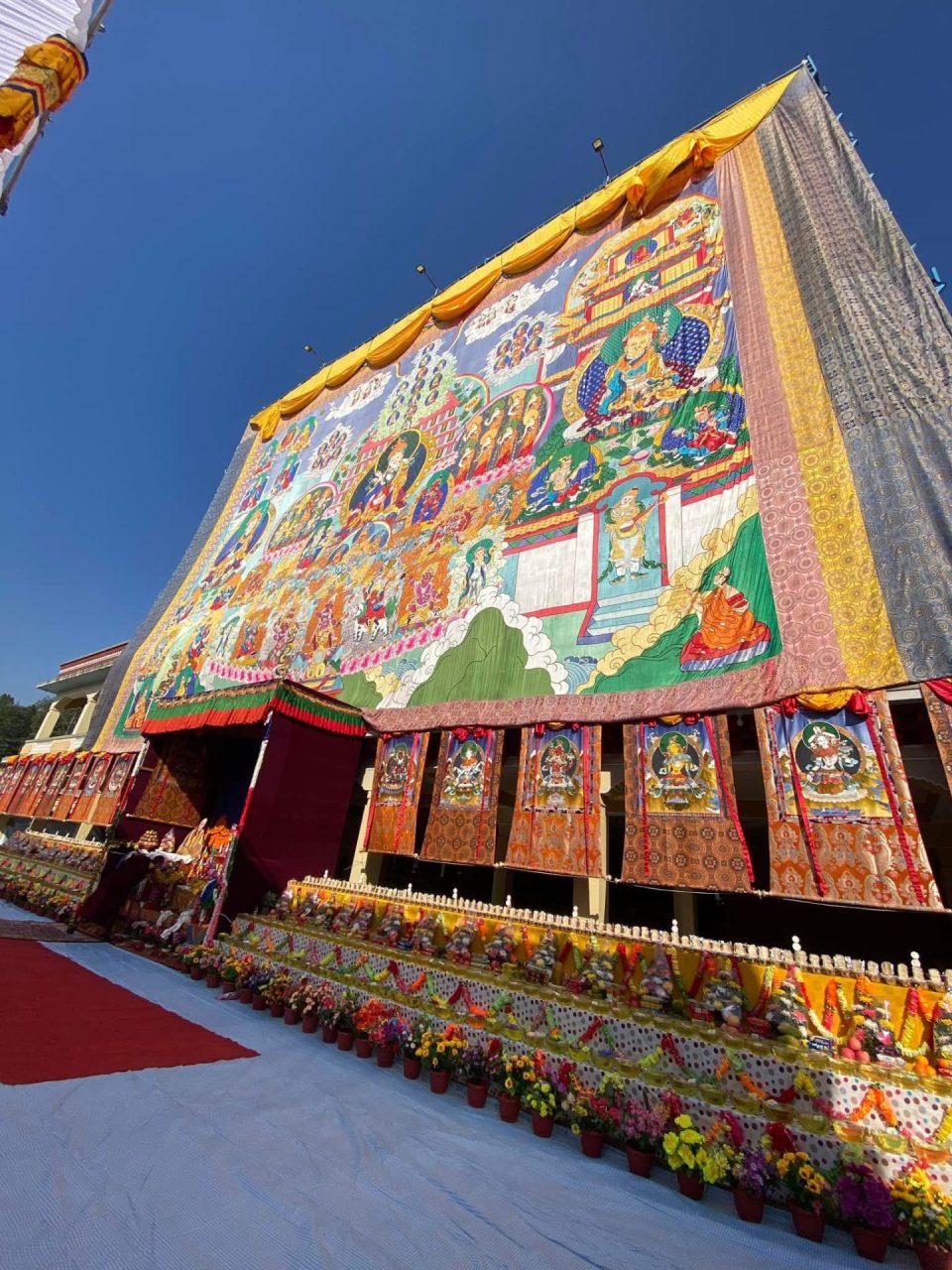
Extensive offerings at the base of the large Padmasambhava thangka during Guru Bumtsog event, 2024. Photo courtesy of Kopan Nunnery.
For the tenth year in a row, a very large thangka of Padmasambhava (Guru Rinpoche) has been displayed and an auspicious 100,000 tsog offering event (Guru Bumtsog) has taken place at Khachoe Ghakyil Ling (Kopan Nunnery). Every year this event will occur on Lama Zopa Rinpoche’s birthday, December 3, to commemorate Rinpoche’s life and dedicate to fulfill Rinpoche’s wishes. Here we share a report from Ven. Sarah Thresher on this year’s event, and some of the meaningful history. Please also read about the history of the Padmasambhava thangka from Geshe Ngawang Sangye.
Celebrating Lama Zopa Rinpoche’s Birthdate with the Annual Guru Bumtsog–a Celebration of the Two Lawudo Lamas
By Ven. Sarah Thresher
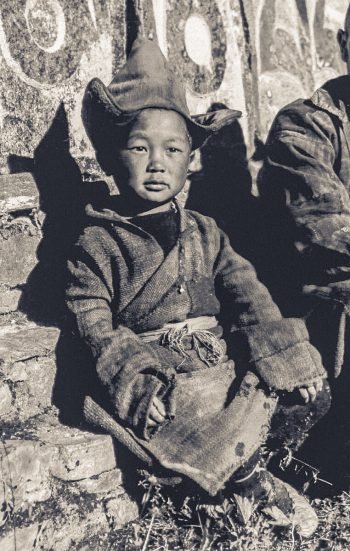
Lama Zopa Rinpoche as a child in Rolwaling. Photo by Tom Weir
Lama Zopa Rinpoche was born at sunrise on a Monday—the last day of the tenth lunar month of the wood bird year (December 3, 1945).[1] He was the fifth of six children, three of whom had died very young. When his mother was five months’ pregnant, she dreamt of entering a large cave with a staircase lined with stone statues of the deity Vajrayogini to whom she paid homage as she ascended, then descended the stairs. On waking, she suspected the child she was bearing could be someone special but told nobody.
One of the most remarkable details of Rinpoche’s birth is that he was born two months before his previous incarnation, Lawudo Lama Kunzang Yeshe, passed away.[2] In fact, Ven Jamyang Wangmo explains in The Lawudo Lama that the first Lawudo Lama actually dreamt of his new incarnation before passing and confided in Charog Lama Kusho Mangde the identity of the young boy who would continue his work for sentient beings.[3] This clearly indicates that Rinpoche was not an ordinary being but a great highly realized master who intentionally entered this world to benefit sentient beings.[4]
One of Rinpoche’s many great activities was the creation of numerous holy objects all over the world, including large thangkas that could be displayed at special times and festivals to help purify and create merit. Another of Rinpoche’s great activities was establishing the annual Guru Bumtsog—100,000 tsog offerings to Guru Rinpoche—for the Kopan monks and nuns and local community, where a huge 75 feet high (23m) by 87 feet wide (27m) silk applique thangka of Padmasambhava and surrounding merit field are displayed, along with 21 more exquisite silk applique thangkas of the Twenty-One Taras below.
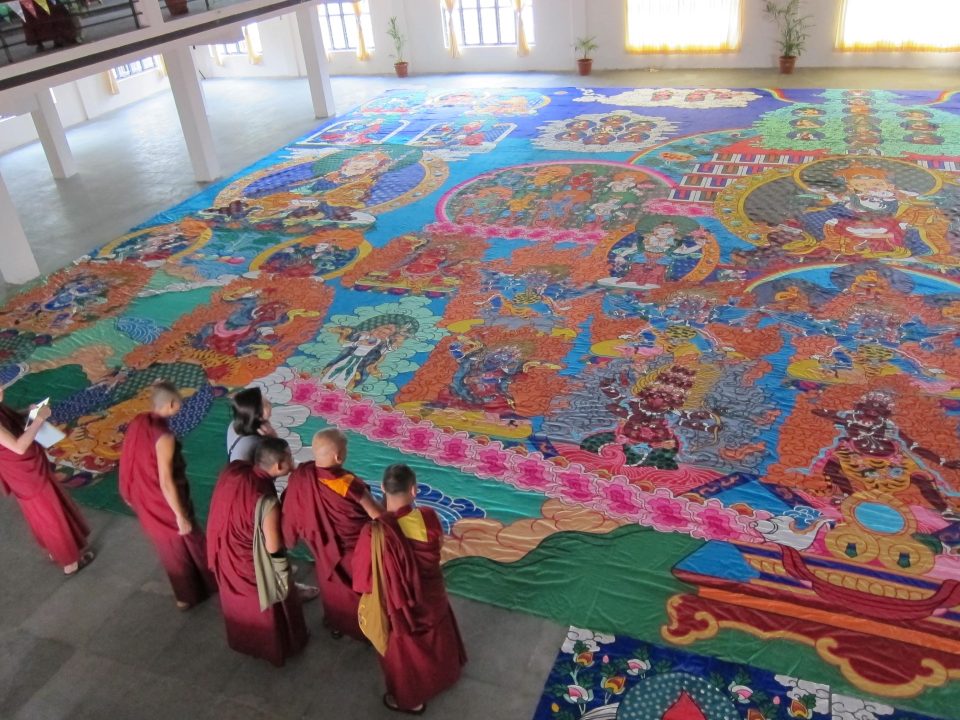
Lama Zopa Rinpoche checking the progress on the Padmasambhava thangka, December 2012.
According to Ven. Thubten Tendar, Rinpoche’s close attendant, Rinpoche’s purpose in establishing the Guru Bumtsog was to pray for all His Holiness Dalai Lama’s wishes to be fulfilled, for peace and prosperity in this world and the elimination of all misfortunes and disasters, and for the preservation and spread of the pure Dharma teachings. Since Rinpoche’s passing, the decision was made to hold the Guru Bumtsog on Rinpoche’s birth date of December 3 each year, and to especially dedicate for all Rinpoche’s holy wishes to be fulfilled, and for everything to be auspicious for the Lawudo Lama’s next emanation.
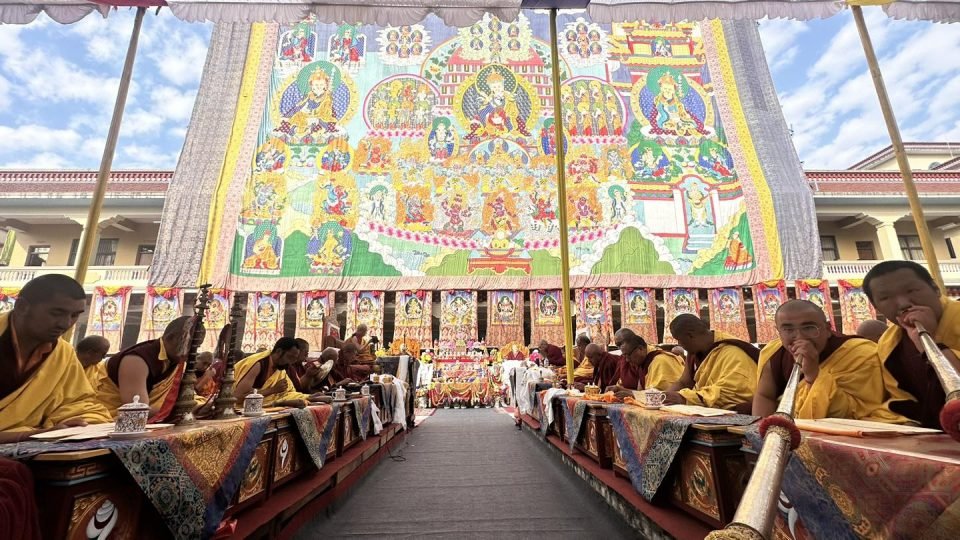
Large Padmasambhava thangka at Kopan Nunnery, December 16, 2023. Photo courtesy of Kopan Monastery.
What makes the event especially poignant is that it is very much a collaborative event between the monks from Thame Monastery, Solu Khumbu—the gompa of the first Lawudo Lama and the monastery that Rinpoche first entered as a young child to become monk—and those of Kopan—the monastery and nunnery founded by Lama Zopa Rinpoche this lifetime. With seamless harmony, the two monasteries work together to make the event a success.
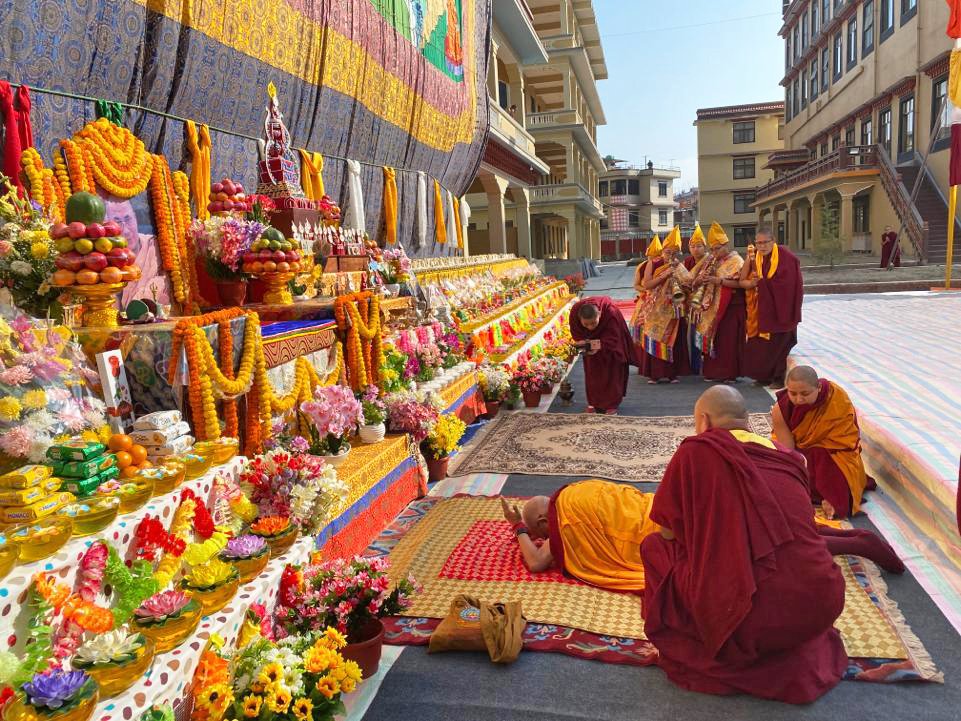
Lama Zopa Rinpoche prostrating to the giant Guru Rinpoche thangka during the Guru bumtsok at Khachoe Ghakyil Nunnery, January 2020.
The text used in the Guru Bumtsog is the Sadhana of the Lineage of Awareness-Holders from the Northern Treasures cycle revealed by Rigdzin Godem. The Northern Treasures is the main lineage practiced in the Thamichowa region of Khumbu where Rinpoche comes from and was the main lineage held by the first Lawudo Lama. Since this is a Nyingma lineage that is not practiced at Kopan, it was Rinpoche’s wish that monks from other monasteries who do hold the lineage lead the puja. This is why it is so important that Thame Monastery chant master, monks and ritual-masters work together with the Kopan monks and nuns to make the puja a success.
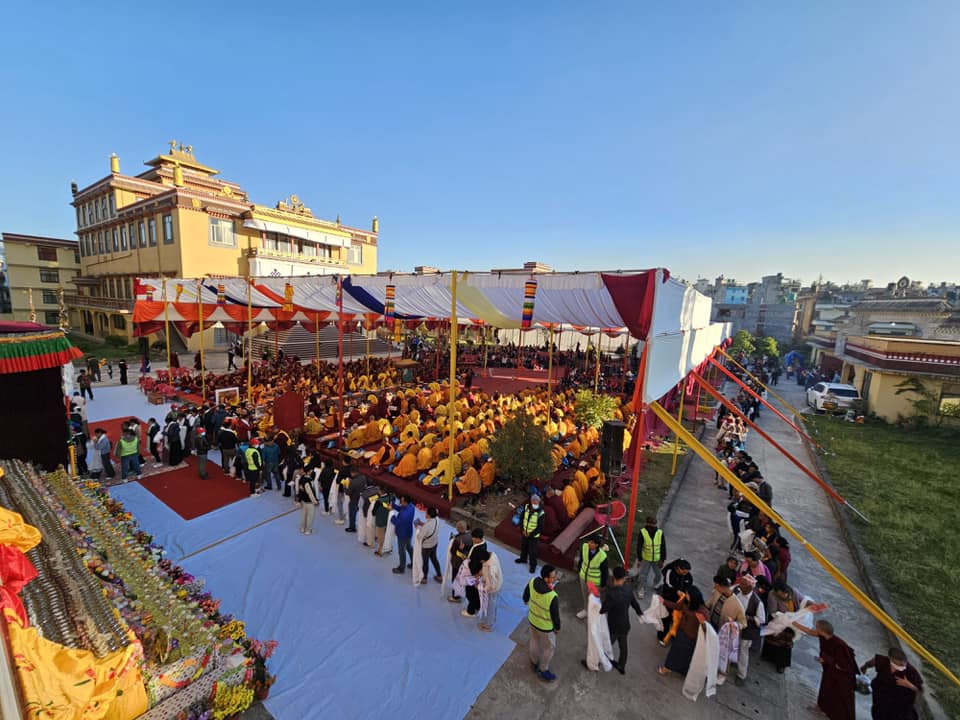
The grounds of Kopan Nunnery during the Guru Bumtsok event on Lama Zopa Rinpoche’s birthday, December 3, 2024. Photo thanks to Kopan Nunnery.
Not only that, but during the day-long Guru Bumtsog, one section is set aside for the Cham dances and most of these religious dances are taken from the Mani Rimdu Festival held at Thame Monastery every year.[5] It means that Kopan monks are trained by the Thame monks to perform the ritual dancing, and both Thame and Kopan monks perform the Cham dances together. The same is true of the gyaling and ritual music which is performed according to the Thame Solu Khumbu tradition that Rinpoche liked so much.
Please watch a beautiful video of this year’s event:
This year’s Guru Bumtsog was again very special. The Thame monk Lhakpa Tenzin expertly lead the chanting while the presiding lama and special guest was His Eminence Jangtse Choeje Gosok Rinpoche of Sera Me. Gosok Rinpoche knew both Lama Yeshe and Lama Zopa Rinpoche from his young days at Buxadaur Refugee Camp, and he told the Kopan monks and nuns about the incredible qualities both Lama and Rinpoche displayed already at that time, and of the exceptional benefit they had brought to this world. It was a visibly moving speech, delivered with a mindfulness that many of the younger sangha may not be aware how truly extraordinary the groundbreaking enlightened activity of Lama and Rinpoche was in this world. May a new emanation of the Lawudo Lama swiftly be revealed to continue the legacy of benefitting numberless sentient beings!
“With seamless harmony, the two monasteries—Thame and Kopan—work together to make the event a success.”
Written by Ven. Sarah Thresher, Nepal, December 4, 2025. Please read more about the rich history of the large Padmasambhava thangka from Geshe Ngawang Sangye.
Ven Sarah Thresher is a senior ordained nun and student of Lama Zopa Rinpohce and has been leading the annual Lawudo Anniversary Pilgrimages to Lawudo Gompa and Retreat Center.
[1] See Jamyang Wangmo, The Lawudo Lama, pp. 107-115 for more details. All these dates have been checked with the Tibetan Medical and Astrological Institute in Dharamsala.
[2] The first Lawudo Lama passed away at midnight of the full-moon day of the first month of the fire dog year (Friday, 15 February 1946).
[3] See Lawudo Lama, p.109 and n. 216.
[4] See Lawudo Lama, ch. 13 for more details of the first Lauwdo Lama’s realizations.
[5] Most of the dances are taken from Thame Mani Rimdu tradition, see Jamyang Wangmo Dancing in the Clouds. However two of them—Hashang and Kinkara Skeleton Couple—were taught to Kopan by Geshe Lama Konchog.
Foundation for the Preservation of Mahayana Tradition (FPMT), is a Tibetan Buddhist organization dedicated to the transmission of the Mahayana Buddhist tradition and values worldwide through teaching, meditation and community service.
2
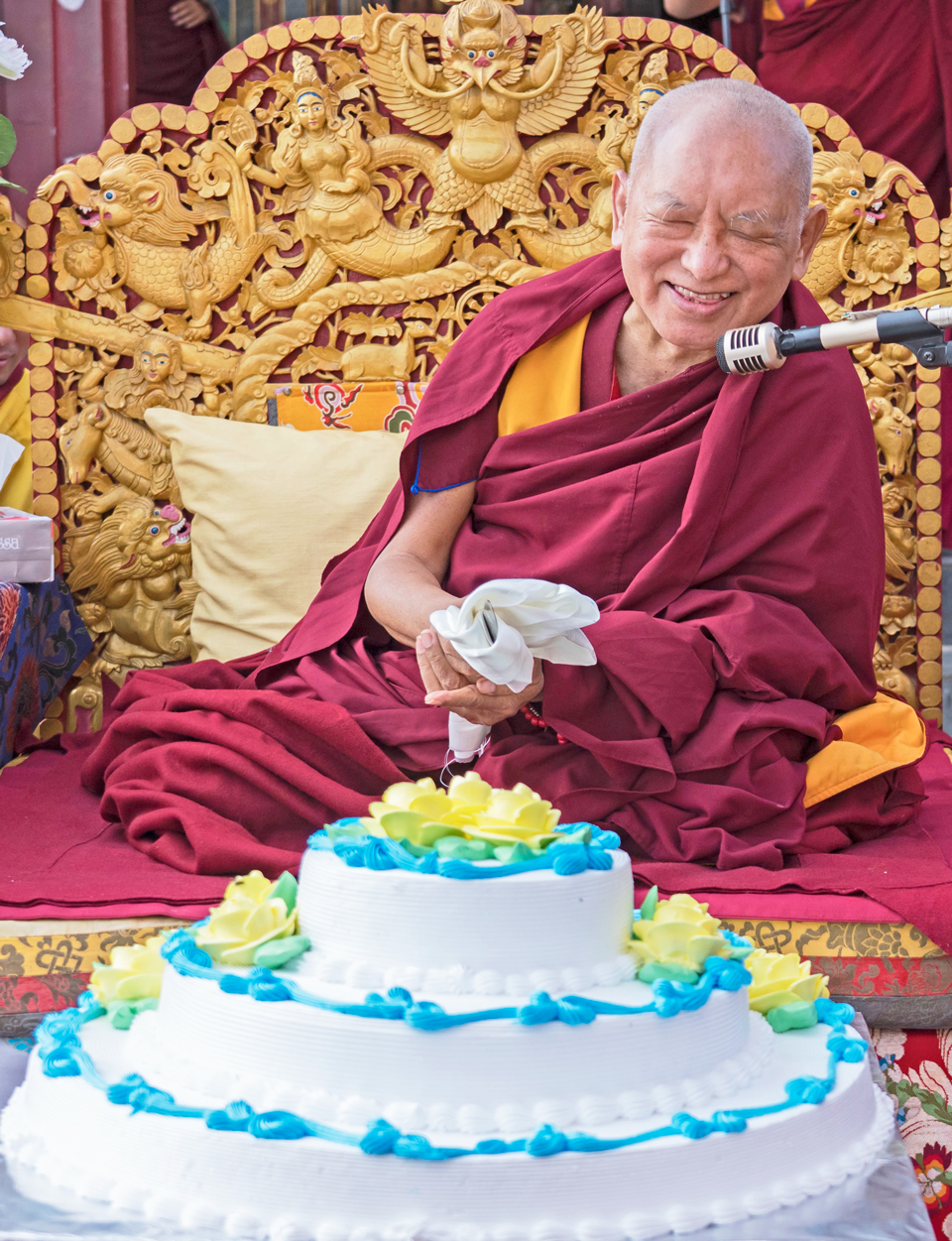
Lama Zopa Rinpoche and cake offered during a birthday celebration, Kopan Monastery, December 2019. Photo by Ven. Lobsang Sherab.
On December 3 we observe the birth date of Lama Zopa Rinpoche.
A very large thangka of Padmasambhava (Guru Rinpoche) will be displayed and an auspicious 100,000 tsog offering event (Guru Bumtsog) will take place at Khachoe Ghakyil Ling (Kopan Nunnery) on this date in honor of Lama Zopa Rinpoche’s birthday, to commemorate Rinpoche’s life and fulfill Rinpoche’s wishes. The event will be presided over by H.E. Jangtse Choeje Kyabje Gosok Rinpoche of Sera Mey Monastery.
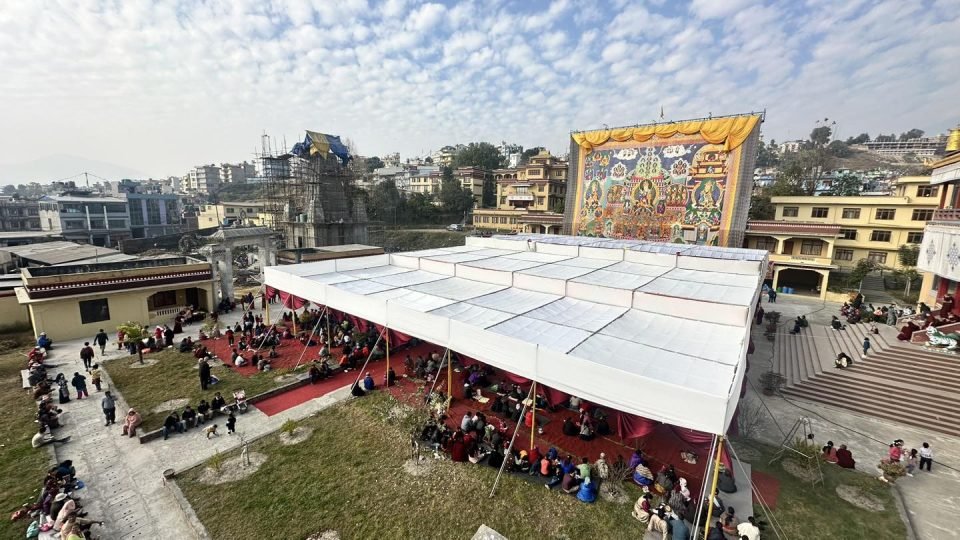
Guru bumtsog event with the large Padmasambhava thangka on display, December 16, 2023. Photo courtesy of Kopan Monastery.
The thangka, which is 75 feet (23 meters) high and 87 feet (27 meters) wide, depicts in stitched appliqué the Padmasambhava merit field in the center. Lama Zopa Rinpoche personally designed and oversaw the creation of this huge thangka and also raised the funds for it, thanks to the kindness of two generous donors. The thangkha was also blessed by His Holiness the Dalai Lama. The incredible weight of the thangka and raising it safely up large scaffolding to display requires tremendous skill and effort. The puja is an incredible undertaking by Kopan monks and nuns as it takes days to set up and arrange, plus lunch offered to all in attendance requires major preparation. This is the tenth year in a row this event has taken place, and now occurs every year on Rinpoche’s birthday, December 3.
Students of Lama Zopa Rinpoche are encouraged to rejoice in this auspicious and powerful event, to pray for Rinpoche’s swift return as advised by His Holiness the Dalai Lama. Please also dedicate for all of Rinpoche’s wishes to manifest without delay, and for the success of the entire FPMT organization.
Lama Zopa Rinpoche (1945-2023) was the spiritual director of the Foundation for the Preservation of Mahayana Tradition (FPMT), a Tibetan Buddhist organization dedicated to the transmission of the Mahayana Buddhist tradition and values worldwide through teaching, meditation and community service.
- Tagged: lama zopa birthday
26
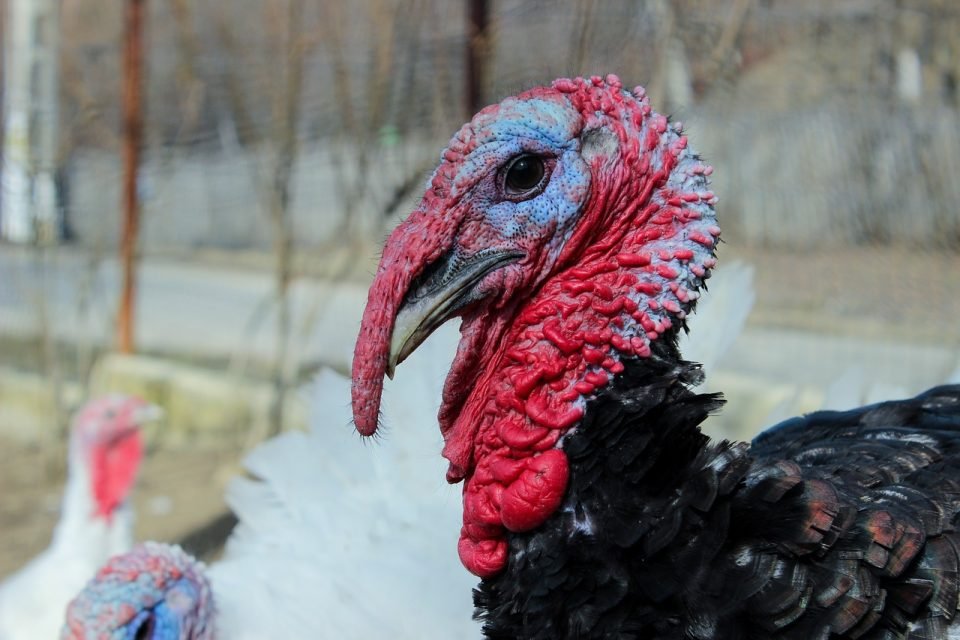
Turkeys at a farm. Photo courtesy of Pixabay.
Every year in the United States, tens of millions of turkeys are killed for the holiday of Thanksgiving, which is this Thursday, November 27, 2025. Lama Zopa Rinpoche offered advice in a 2018 teaching to help benefit the turkeys killed, and how we can think during the holiday. Rinpoche explained that these practices can be applied beyond the Thanksgiving holiday, “These are simple methods, but they have unbelievably profound benefits, like the sky. You can also do more or different practices as well. These are just suggestions. You can also do these practices at Christmas or on other occasions where turkeys and so many other animals are sacrificed and eaten.”
In “Prayers and Practices to Do for Turkeys at Thanksgiving”, Rinpoche explains,
“If you are Buddhist, or just someone who does not want to suffer now or in endless future lives as well, having to experience unbelievably suffering, you need to purify your past negative karma and stop creating any more so that you will not be reborn as a turkey over and over again. … If you do have to eat turkey because of some family obligation, then at least do some mantras and prayers to benefit the turkeys, such as the four immeasurables with tonglen. Otherwise, if you just enjoy eating turkey together with the rest of the Americans who are not Buddhist, who do not know Dharma, who have not generated compassion for the turkeys, you create much negative karma.”
In this teaching Rinpoche provides detailed instructions on practices to purify negative karma, such as Vajrasattva, taking the eight Mahayana precepts, reciting sutras, engaging in nyung ne fasting retreats, generating love and compassion through the practice of tonglen and the Four Immeasureables, practicing Chenrezig, Medicine Buddha puja and specific mantras. Rinpoche also offers a special dedication to purify any negative karma that could cause future rebirth as a turkey.
Of course, Rinpoche also has given extensive advice for benefiting animals and we invite you to explore all the resources available to you.
For links to practice materials in these detailed instructions, we invite you to read “Prayers and Practices to Do for Turkeys at Thanksgiving”.
For more mantras and resources for mantra recitation, visit FPMT Education Services’ page on mantras. You can find a full catalogue of all FPMT prayers, practices, and advice materials on FPMT.org.
Foundation for the Preservation of Mahayana Tradition (FPMT), is a Tibetan Buddhist organization dedicated to the transmission of the Mahayana Buddhist tradition and values worldwide through teaching, meditation and community service.
- Tagged: thanksgiving
13
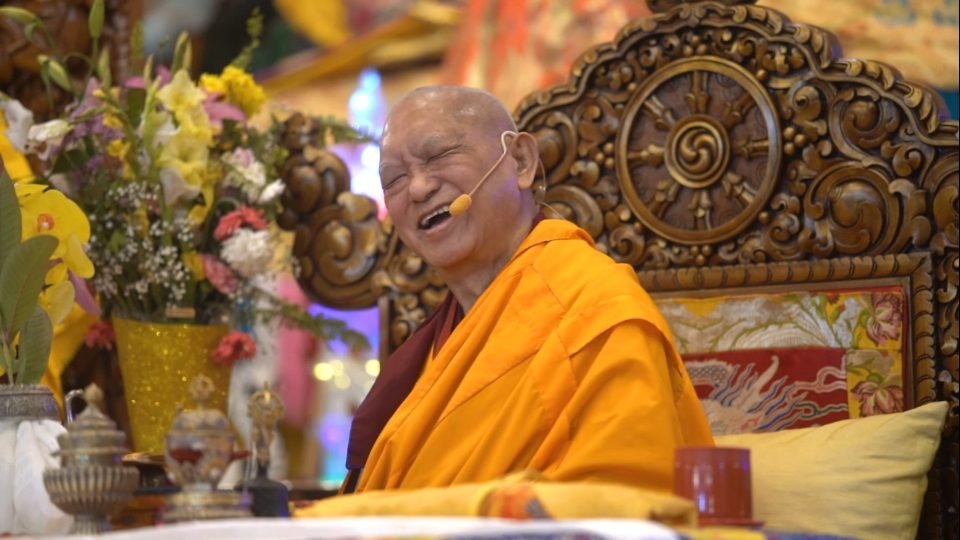
Lama Zopa Rinpoche teaching at the fifty-third lamrim meditation course at Kopan Monastery, December 25, 2022.
Lama Zopa Rinpoche offered seventeen teachings during the fifty-third month-long lamrim meditation course at Kopan Monastery in Nepal which occurred November 26 to December 26, 2022. All videos from this course are available on video in English (with and without transcript overlay), Italian, Spanish, Russian and Chinese.
Today we are sharing one video from this course, “Others’ Happiness Depends on How You Act with Your Body, Speech, and Mind.”
In this teaching, Rinpoche explains that others’ happiness depends on how we act with our body, speech, and mind. Not only within our families, but everywhere we go in the world, anyone we meet, even animals, their happiness is in our hands, so we must be kind and peaceful. We have responsibility for the happiness and suffering of others, not just for our own. Therefore, we must be kind with our body, speech, and mind by doing pleasant actions to others.
No one, including animals, likes rude sounds directed at them, this causes others to feel threatened or run away. We can offer a smile from our heart to others, it not only creates the cause to be a very beautiful person in future lives, it also becomes the cause of enlightenment when done with bodhicitta. We can also be kind to others with our mind—how we think about those we meet, cultivating loving-kindness and compassion toward them, this is incredible. By having a good heart benefiting others, everything becomes the cause of enlightenment.
Please watch Rinpoche offer this teaching on December 11 ,2022: Others’ Happiness Depends on How You Act with Your Body, Speech, and Mind:
You are welcome to explore all seventeen teachings from the 2022 Kopan Course, offered by Lama Zopa Rinpoche. You may also utilize a full transcript of the entire course.
FPMT.org offers a collection of practical advice from Lama Zopa Rinpoche. Students can also find Rinpoche’s advice on a wide range of topics in the form of short talks and letters at the Lama Yeshe Wisdom Archive.
9
We are so pleased to share Wisdom Publication’s new release, How to Live and Die: The Transformative Power of Meditating on Impermanence by Lama Zopa Rinpoche. In this overview of one of the most important practices in Tibetan Buddhism—meditating on death and impermanence—Rinpoche shows us how this practice can free us from fear, deepen our wisdom, and transform the way we live. Wisdom is very kindly offering a 20% discount to FPMT students through October 31! Please use code fpmt-hld20 at checkout when ordering your copy of Rinpoche’s new book!
Please enjoy this excerpt from How to Live and Die:
A complete education about death is the most important education we can have. What death is, how we die, what minds we need at death, and what happens after death—only by knowing about death and rebirth can we actually fully understand what life is and so learn how to live fully.
In the West, such questions are generally not studied. What happens at the very beginning of this life and at the end are like two big black holes; there is no clarity. Even if there are some scientific explanations, these are based on hypotheses, not on personal experience. It seems that if scientists cannot verify something with their instruments, it doesn’t exist for them. They can explain how, at death, the cells break down and the brain stops functioning, but they cannot go beyond that, and they can never address the real question of what happens to us at death.
While Buddhism might not talk about molecular structures or details such as that, on another level it has the whole answer, the complete education on life, death, and rebirth, especially when we study the subtle explanations given in the Vajrayana, the tantric teachings, which explain about the gross, subtle, and very subtle bodies and minds.
Suddenly, without any warning, death is there facing us. Life is gone, and there is nothing we can do about it. Our time to meditate, to develop our mind, has run out. Now, for the first time, we are facing the reality of life, and no matter how much fear we have, there is no time to do anything to remedy it.
When that happens, there is so much regret. When we die, it is said that we see our whole life clearly, like watching a documentary with everything we have ever done vividly played back to us—all the mistakes, all the selfishness, all the harm we have done to others. I have often heard that when people go through this, they die overwhelmed with great terror and regret. Even for somebody who rejects reincarnation, there is still great fear that something terrible is about to happen.
For worldly people, success has nothing to do with the mind. Their definition of success is being wealthy and famous. To have properties in many countries, to be able to make millions or billions of dollars in business; that is the definition of a successful life. Whoever can make the most money is regarded as the most successful—regardless of how stressful or berserk the life of that millionaire or billionaire actually is.
In fact, their inner life could be extremely unhappy, fragmented into pieces, with so much depression, sadness, dissatisfaction, and discontentment. Their life could be full of suffering—worse, even, than the poorest beggar, whose mind might be quite peaceful, with neither reputation nor wealth that could be lost. This happens because, relying on external things for happiness, their strong attachment has caused them to harm others (and themselves) to get what they want. They have no idea that true happiness only comes from developing a good heart.
Working solely for the comforts of this life is not what being a human is all about. Even animals do this. This is something even worms, rats, or ants can do, so the billionaire is no better than the worm in this. If we only work for material comfort, we will die with such regret. We need to go beyond this. We need to at least try to obtain a better rebirth. Then we will be able to die without fear, having the potential to continue to develop our Dharma practice in our next life.
Until we can fully understand our own life—how it is impermanent and how death is inevitable—it is very difficult to fully appreciate the unique opportunity we now have with this perfect human rebirth. Without that appreciation, the rest of the path to enlightenment will make little sense. That is why I say that understanding impermanence and death is the most important education we can have.
The teachings on impermanence and death come very early on in the Tibetan Buddhist system of study and practice known as lamrim, which means “graduated path.” The lamrim was first explained by the great master Atisha in his Lamp for the Path to Enlightenment. In the lamrim, the entire teachings of Guru Shakyamuni Buddha are divided into a step-by-step approach, set up to lead us from where we are now all the way to enlightenment.
In traditional texts, such as Lama Tsongkhapa’s Great Treatise on the Stages of the Path to Enlightenment (Lamrim Chenmo) and Pabongka Dechen Nyingpo’s Liberation in the Palm of Your Hand, we see that after discussing how to rely on the spiritual teacher, the lamrim begins with explaining the value and rarity of this precious human life, with its eight freedoms and ten richnesses, followed by an extensive exploration of the reality of impermanence and death. These first steps on the path show us how we need to seize this life firmly and make the most of it.
Excerpted from How to Live and Die: The Transformative Power of Meditating on Impermanence by Lama Zopa Rinpoche, Wisdom Publications, 2025. The book was edited and sponsored by the Lama Yeshe Wisdom Archive.. Don’t forget to use code fpmt-hld20 at checkout by October 31 to receive a 20% discount!
You can access and utilize more of Lama Zopa Rinpoche’s precious advice on death, dying, and impermanence.
Foundation for the Preservation of Mahayana Tradition (FPMT), is a Tibetan Buddhist organization dedicated to the transmission of the Mahayana Buddhist tradition and values worldwide through teaching, meditation and community service.
- Tagged: impermanence and death, lama zopa rinpche
5
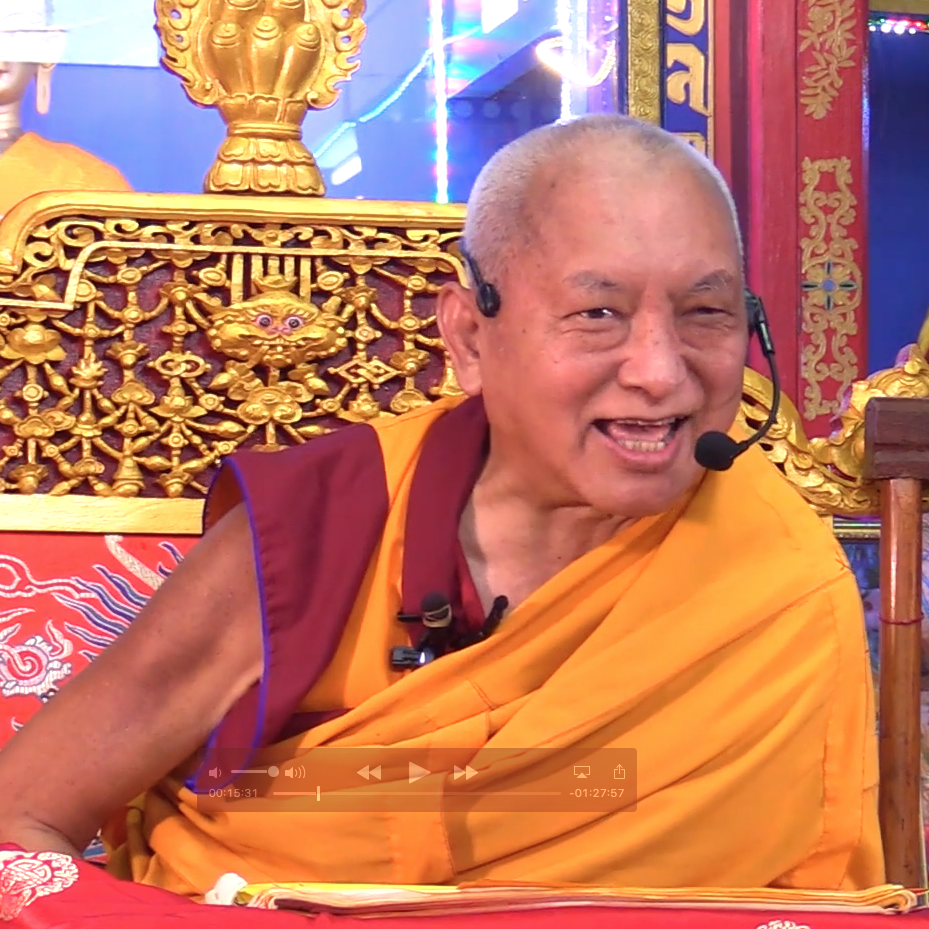
Lama Zopa Rinpoche teaching at Root Institute, Bodhgaya, India, January 2017.
Lama Zopa Rinpoche offered a series of teachings in January 2017 at Root Institute, Bodhgaya, India. In these teachings Rinpoche put strong emphasis on lojong (mind training) and even gave a full commentary on the Seven-Point Thought Transformation by Kadampa Geshe Chenkawa on February 5). This teaching was condensed and turned into a course on the FPMT Online Learning Center: Living in the Path, Lojong, “Transforming Kaka into Gold.”
In one of these teachings, Rinpoche offered precious advice at about how to think and practice when working for a Dharma center. Rinpoche discusses proper service, emphasizing to take the teachings to heart and apply them to the everyday challenges in the center, right here and now in daily life. The most important thing, Rinpoche stresses, is to generate bodhichitta and apply it in everything you do and to the people around you. The purpose to serve them, not them to serve you. Always think: “I am the servant here. I have to serve everyone. This is the biggest puja!”
We invite you to enjoy this video teaching of Lama Zopa Rinpoche offering this precious advice:
Other topics discussed in this series of teachings include:
- Dzambhala and purification practice
- How to properly offer service
- Dangers of the self-cherishing thought
- The importance of patience
- The downfalls of anger
- How to practice the generation of bodhicitta
We invite you to peruse the summaries of these videos and find topics of interest to you, or simply watch each video in order to benefit from the entire series. You can find all of the videos from this teaching event on our Rinpoche Available Now resource.
Lama Zopa Rinpoche kindly offered teachings regularly at FPMT centers around the world. Many of these teachings are available as video and audio recordings together with other resources as a part of our Rinpoche Available Now (RAN) project. View the collection of full-length video teachings.
Lama Zopa Rinpoche (1945-2023) was the spiritual director of the Foundation for the Preservation of Mahayana Tradition (FPMT), a Tibetan Buddhist organization dedicated to the transmission of the Mahayana Buddhist tradition and values worldwide through teaching, meditation and community service.
22
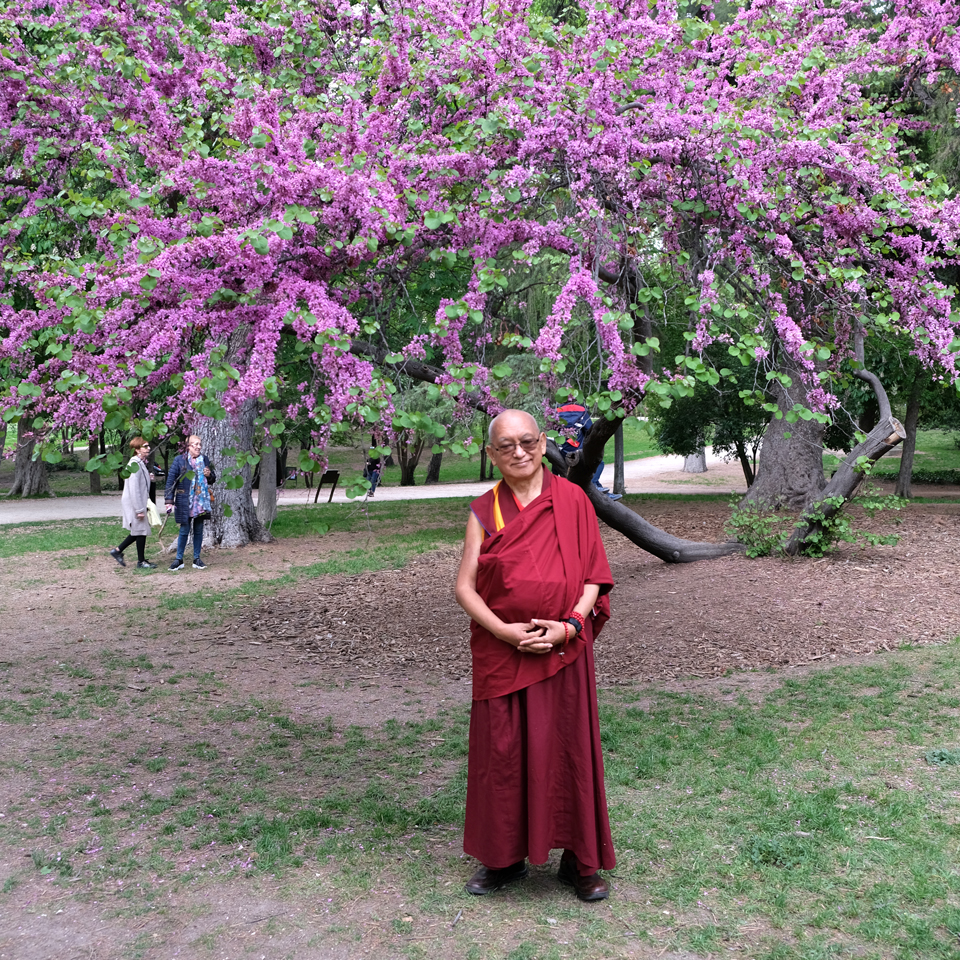
Lama Zopa Rinpoche enjoying a park in Madrid, Spain, April 2019. Photo by Ven. Roger Kunsang.
In April 2019 Lama Zopa Rinpoche gave series of teachings at Nagarjuna center in Madrid, Spain. Today we are sharing the first video from that event, “How to Have a Happy Life With a Happy Mind.”
The purpose of one’s life is to not harm and to benefit others, Rinpoche explains. By enjoying the life with Dharma you don’t make your mind sick. Rather, you will have a happy life, happy mind, and from this comes a healthy body. With your body, speech, and mind —whatever you do, you do it to benefit others. Rinpoche stresses that the other important thing is looking at the “I,” that exists in mere name, but does not exist from its own side. “By practicing mindfulness on this, then you will have a healthy life and healthy mind. You don’t create the cause of samsara. This is the best life, happiest life, most meaningful life, to practice BODHICHITTA. At least to have a good heart, to not harm others, and on top of that—to benefit others.”
Please watch the video of Rinpoche teaching “How to Have a Happy Life With a Happy Mind”
You are very welcome to peruse all videos from this teaching event from 2019 in Madrid, Spain, which were translated into French, Spanish, and Italian. You can also find a full transcript of this event.
Lama Zopa Rinpoche offered teachings regularly at FPMT centers around the world. Many of these teachings are available as video and audio recordings together with other resources as a part of our Rinpoche Available Now (RAN) project. View the collection of full-length video teachings.
FPMT.org offers a collection of practical advice from Lama Zopa Rinpoche. Students can also find Rinpoche’s advice on a wide range of topics in the form of short talks and letters at the Lama Yeshe Wisdom Archive.
14
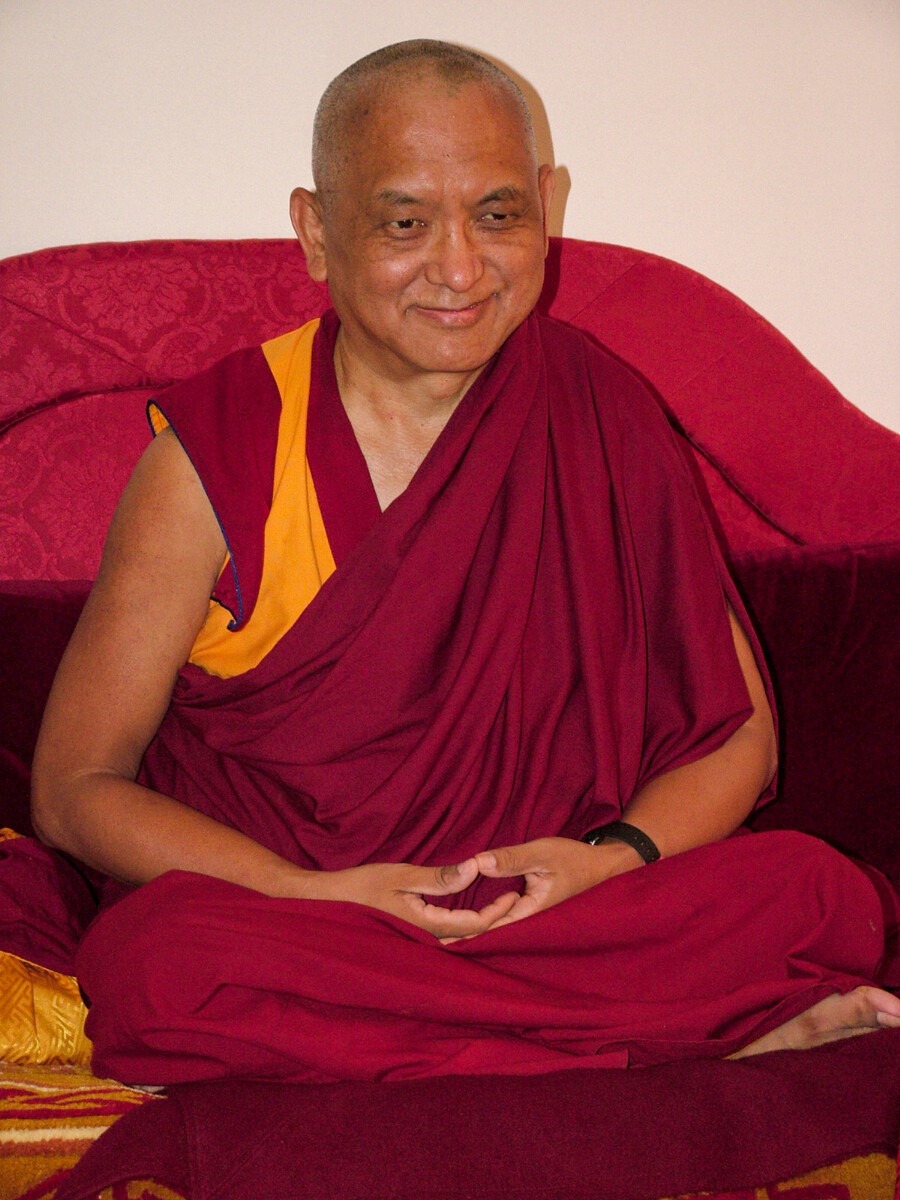
Lama Zopa Rinpoche in Italy, September 2004. Photo by Ven. Roger Kunsang.
Recently we shared that 44 new 2004 videos of Lama Zopa Rinpoche teaching at Istituto Lama Tzong Khapa, Italy, are now available. Today we’d like to bring your attention to one of these precious teachings, Overcoming Obstacles with Lojong: Transforming Suffering into Cause of Happiness.
In this teaching, Rinpoche first discusses the meaning of protector prayers and the motivation for doing them for success in Dharma activities around the world. Happiness and suffering are created by one’s own mind, not by others, Rinpoche explains, and one has complete freedom to stop suffering and achieve happiness up to enlightenment by changing how one thinks. Rinpoche reminds us that centers play an important role in world peace by educating people about the mind, karma, compassion, and thought transformation. By practicing thought transformation (lojong), one can transform all obstacles and problems into causes for enlightenment. A key point Rinpoche stresses in this teaching is:
If you are happy, practice Dharma, if you are unhappy, practice Dharma.
Please watch the entire video of Rinpoche offering this teaching:
This teaching was given on September 11, 2004 at Istituto Lama Tzong Khapa, Italy during a Ganden Lha Gyama retreat.
These collection of 44 teachings provided a comprehensive overview of key Buddhist concepts, focusing on how to integrate them into daily practice to progress on the path to enlightenment. All of these sessions are now available for students to explore as they wish. On this page, you can also find a full combined transcript of these teachings, more information about the sessions, and MP3 audio download.
FPMT.org offers a collection of practical advice from Lama Zopa Rinpoche. Students can also find Rinpoche’s advice on a wide range of topics in the form of short talks and letters at the Lama Yeshe Wisdom Archive.
- Tagged: advice from lama zopa rinpoche, lojong
7
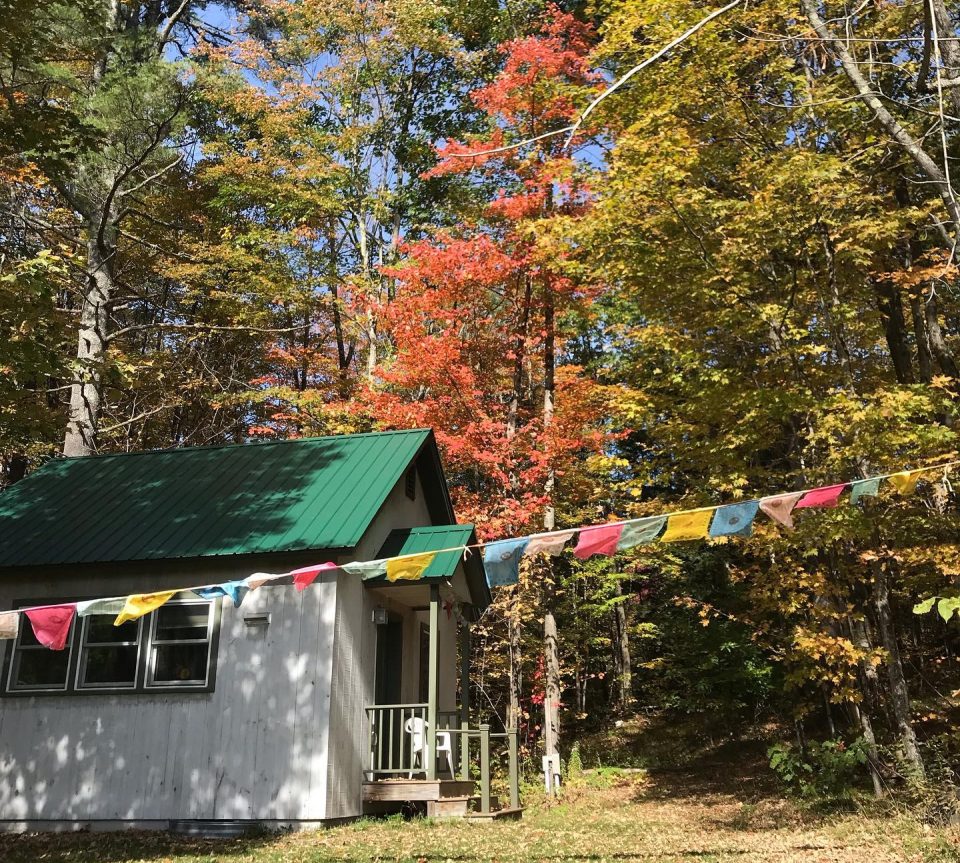
One of the retreat cabins at Milarepa Center, Vermont, USA.
Describing the significance of one of his Vast Visions for the FPMT organization, supporting practice and realizations, Lama Zopa Rinpoche said, “Anybody who dedicates their life to achieving lamrim realizations with the goal to liberate numberless beings from the oceans of samsaric suffering and to bring to enlightenment, this is what I regard as the most important thing in the world.” In Rinpoche’s book, Heart Advice for Retreat, he further explains:
“What is the importance of doing retreat? Why do people need to do retreat? It is not simply to be quiet, to have a break from one’s family. Instead, there are very crucial reasons for doing retreat, very urgent reasons.
“One simple reason is happiness. The peace and happiness of parents, for example, depend upon their children’s having affection and compassion towards them. And the children’s peace and happiness depend upon their parent’s affection and compassion. The same is true for couples or partners: each member’s peace, happiness, and success depend upon the compassion and kindness of the other person. For teachers and students as well, their peace and happiness depend upon one another.
“On a larger scale, the relationship between the leader of a country and its population also depends upon their cultivation of a proper attitude, a good heart, and compassion. And if one person is avoiding bringing problems such as violence to a country or even to the whole world, that too depends upon his or her development of compassion, loving kindness, and a good heart. …”
In 2006, Rinpoche wrote a letter to a student who had been engaged in retreat for fifteen months. One excerpt reads:
“You are making the best progress in your retreat because you are seeing lam-rim more and more deeply. This means your retreat is benefiting your mind. You have developed a very deep realization of how terrible samsara is. You understand it is nothing but suffering. You know you have experienced rebirth in samsara numberless times and continuing to reincarnate in this samsara is incredibly unbearable and disgusting.
“This sort of realization is very important. We need to experience the suffering of samsara as unbearable and totally in the nature of suffering – not only the suffering of pain and the suffering of change, but also pervasive compounded suffering. This means the aggregates themselves are in the very nature of suffering.
“Not only is samsara in the nature of suffering, but what we perceive as happiness often results from committing negative actions. These negative actions plant seeds of delusion in our minds. More delusion arises from that seed, and more negative karma arises from that delusion. In this way, we constantly create the cause of compounded suffering.” Please read the whole letter.
FPMT retreat centers span the globe in a variety of beautiful locations and several centers also offer the opportunity to do Buddhist retreats in the heart of the city. These centers offer everything from intensive meditation on Tibetan Buddhist practices to a relaxing environment for reflection and discovery. Please explore the many retreat facilities and opportunities available to you at FPMT centers worldwide.
Download Lama Zopa Rinpoche’s Heart Advice for Retreat.
Foundation for the Preservation of Mahayana Tradition (FPMT), is a Tibetan Buddhist organization dedicated to the transmission of the Mahayana Buddhist tradition and values worldwide through teaching, meditation and community service.
- Tagged: heart advice for retreat, retreat, retreat cabin
28
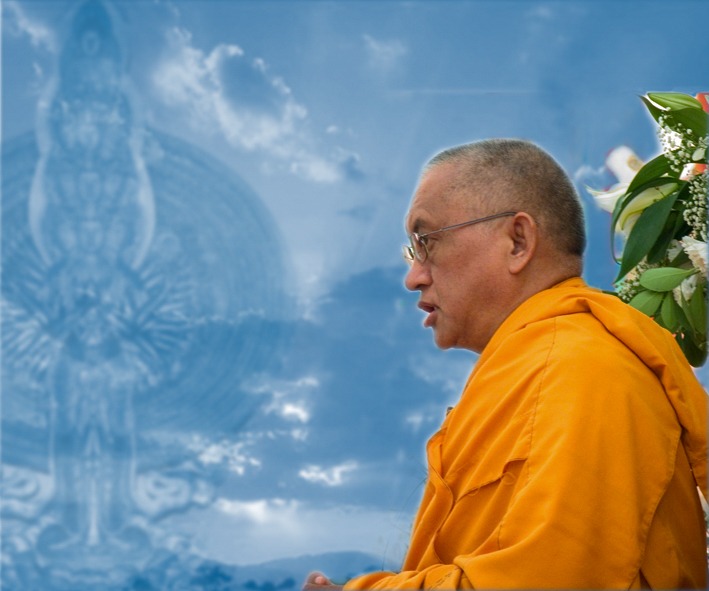
Lama Zopa Rinpoche at Istituto Lama Tzong Khapa, Italy, September 29, 2004. Photo by Ven. Roger Kunsang.
In 2004, Lama Zopa Rinpoche covered many topics during a Ganden Lha Gyama retreat from September 3-30 at Istituto Lama Tzong Khapa, Italy. The 44 teaching sessions covered the following topics, broadly:
- Integration of study and meditation
- The importance of lamrim and Guru Yoga
- How to do deity retreats
- Bodhicitta and compassion
- Emptiness and appearances
- Karma and responsibility
- Power of words and mind
- The preciousness of perfect human rebirth
- Four Noble Truths
- Universal responsibility and dedication to others
- Merit accumulation and purification practices
We are so pleased to share that all of these teachings are now available!
These teachings provided a comprehensive overview of key Buddhist concepts, focusing on how to integrate them into daily practice to progress on the path to enlightenment. All of these sessions are now available for students to explore as they wish. On this page, you can also find a full combined transcript of these teachings, more information about the sessions, and MP3 audio download.
FPMT.org offers a collection of practical advice from Lama Zopa Rinpoche. Students can also find Rinpoche’s advice on a wide range of topics in the form of short talks and letters at the Lama Yeshe Wisdom Archive.
23
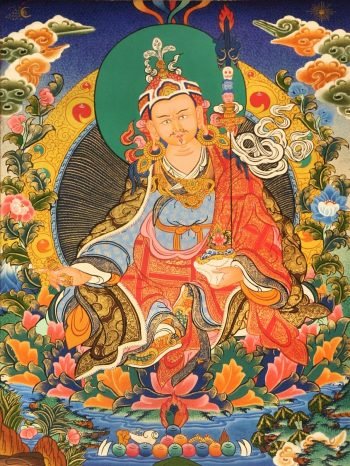
Padmasambhava (also known as Guru Rinpoche)
In 2022, after the war in Ukraine started, Lama Zopa Rinpoche offered advice on prayers and practices to do in order to pacify the threats of war. All are welcome to download the booklet, Prayers to Stop War.
At the time, Lama Zopa Rinpoche also gave advice for how to motivate and think when doing these prayers and practices:
At the beginning generate strong bodhicitta, then do these prayers and practices to stop the war. The main purpose is to stop the war immediately. Then also to prevent famine, disease, and all the dangers of earth, water, fire, and wind, for all these dangers to be pacified immediately. To fill the whole world with perfect peace and happiness, including enlightenment, and to generate loving kindness, compassion and bodhicitta in the heart of all sentient beings.
Think that from Guru Padmasambhava’s heart, beams radiate and totally purify all the six realms’ sentient beings, totally purify all the delusions and negative karmas collected from beginningless rebirths, especially anger, attachment, and ignorance; think that these are totally purified. Then recite Sampa Lhundrupma, followed by the Padmasambhava mantra (one or two malas).
With strong faith in Guru Padmasambhava and total reliance, Guru Padmasambhava will definitely help because his compassion embraces all sentient beings.
Then another way to think is, with strong faith in His Holiness the Dalai Lama in the aspect of Guru Padmasambhava, nectar beams are emitted to all leaders of war, entering the body and totally purifying all negative karma and obscurations; all the dissatisfied mind, desire, ignorance, anger, and selfish mind are totally purified; they generate bodhicitta especially, and then the whole path to enlightenment. Do that very strongly, making strong prayers to His Holiness the Dalai Lama.
Then nectar beams are also emitted to all involved, and these purify all the anger and self-cherishing thought. They generate bodhicitta, and stop giving harm to even one sentient being and only benefit sentient beings, up to enlightenment.
Then recite the Heart Sutra and the prayer to stop wars.
For those who can do the Most Secret Hayagriva sadhana, do this at the beginning of the practice. When reciting the mantra, you can do the same visualizations as above.
Lama Zopa Rinpoche gave this advice in 2022 to IMI Sangha on prayers and practices they could do in response to the developing war in Ukraine. The above motivation was edited slightly to be more general in order to be relevant for current threats at any time. The original advice can be read here. Please download Prayers to Stop War .
Foundation for the Preservation of Mahayana Tradition (FPMT), is a Tibetan Buddhist organization dedicated to the transmission of the Mahayana Buddhist tradition and values worldwide through teaching, meditation and community service.
6
A new playful and heartwarming free book is available from the Lama Yeshe Wisdom Archive: Rinpoche’s Animal Friends. This book showcases more than one hundred images of the soft toys, also known as plushies, which appeared regularly in Lama Zopa Rinpoche’s video teachings from Kopan during his 2020-2022 thought transformation teachings. These animal friends were later gifted to students around the world.
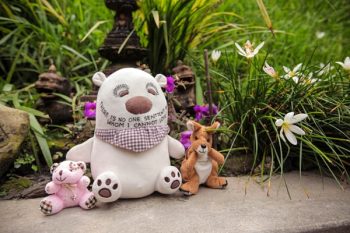
“There is no one sentient being whom I cannot love.” – Lama Zopa Rinpoche
The plushies were decorated and blessed by Rinpoche, who wrote or dictated profound Dharma messages and added whimsical creative touches. Many of the toys feature powerful mantras which purify negative karma just by seeing, touching and reciting them. The quotations on the toys are supplemented by teaching excerpts on the three principal aspects of the path—renunciation, bodhicitta and emptiness.
This book is a reminder of Rinpoche’s great love for us and his unique means to inspire and open our hearts. While this is not a typical children’s book, it can be shared with young people of all ages to enjoy the pictures and the engaging Dharma messages.
Subscribe to the LYWA monthly e-letter and keep up with the latest news and publications.
Foundation for the Preservation of Mahayana Tradition (FPMT), is a Tibetan Buddhist organization dedicated to the transmission of the Mahayana Buddhist tradition and values worldwide through teaching, meditation and community service.
- Home
- News/Media
- Study & Practice
- About FPMT Education Services
- Latest News
- Programs
- New to Buddhism?
- Buddhist Mind Science: Activating Your Potential
- Heart Advice for Death and Dying
- Discovering Buddhism
- Living in the Path
- Exploring Buddhism
- FPMT Basic Program
- FPMT Masters Program
- FPMT In-Depth Meditation Training
- Maitripa College
- Lotsawa Rinchen Zangpo Translator Program
- Universal Education for Compassion & Wisdom
- Online Learning Center
- Prayers & Practice Materials
- Overview of Prayers & Practices
- Full Catalogue of Prayers & Practice Materials
- Explore Popular Topics
- Benefiting Animals
- Chenrezig Resources
- Death & Dying Resources
- Lama Chopa (Guru Puja)
- Lama Zopa Rinpoche: Compendium of Precious Instructions
- Lama Zopa Rinpoche: Life Practice Advice
- Lama Zopa Rinpoche Practice Series
- Lamrim Resources
- Mantras
- Prayer Book Updates
- Purification Practices
- Sutras
- Thought Transformation (Lojong)
- Audio Materials
- Dharma Dates – Tibetan Calendar
- Translation Services
- Publishing Services
- Teachings and Advice
- Find Teachings and Advice
- Lama Zopa Rinpoche Advice Page
- Lama Zopa Rinpoche: Compendium of Precious Instructions
- Lama Zopa Rinpoche Video Teachings
- ༧སྐྱབས་རྗེ་བཟོད་པ་རིན་པོ་ཆེ་མཆོག་ནས་སྩལ་བའི་བཀའ་སློབ་བརྙན་འཕྲིན།
- Podcasts
- Lama Yeshe Wisdom Archive
- Buddhism FAQ
- Dharma for Young People
- Resources on Holy Objects
- Ways to Offer Support
- Centers
- Teachers
- Projects
- Charitable Projects
- Make a Donation
- Applying for Grants
- News about Projects
- Other Projects within FPMT
- Support International Office
- Projects Photo Galleries
- Give Where Most Needed
- FPMT
- Shop
Translate*
*powered by Google TranslateTranslation of pages on fpmt.org is performed by Google Translate, a third party service which FPMT has no control over. The service provides automated computer translations that are only an approximation of the websites' original content. The translations should not be considered exact and only used as a rough guide.Buddhist meditation doesn’t necessarily mean sitting cross-legged with your eyes closed. Simply observing how your mind is responding to the sense world can be a really perfect meditation and bring a perfect result.
